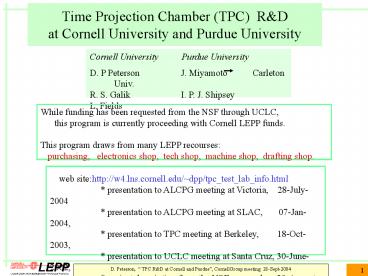Time Projection Chamber (TPC) R - PowerPoint PPT Presentation
Title:
Time Projection Chamber (TPC) R
Description:
Time Projection Chamber TPC R – PowerPoint PPT presentation
Number of Views:81
Avg rating:3.0/5.0
Title: Time Projection Chamber (TPC) R
1
Time Projection Chamber (TPC) RD at Cornell
University and Purdue University
Cornell University Purdue University D.
P Peterson J. Miyamoto
Carleton Univ. R. S. Galik
I. P. J. Shipsey L. Fields
While funding has been requested from the NSF
through UCLC, this program is currently
proceeding with Cornell LEPP funds. This program
draws from many LEPP recourses purchasing,
electronics shop, tech shop, machine shop,
drafting shop.
web sitehttp//w4.lns.cornell.edu/dpp/tpc_t
est_lab_info.html
presentation to ALCPG meeting at Victoria,
28-July-2004 presentation
to ALCPG meeting at SLAC, 07-Jan-2004,
presentation to TPC meeting at
Berkeley, 18-Oct-2003,
presentation to UCLC meeting at Santa Cruz,
30-June-2002, project
description from the NSF proposal,
29-August-20 UCLC web sitehttp//w4.lns.corn
ell.edu/public/LC/UCLC/projects.html There is
also information on other TPC work in the
workshop proceedings.
2
TPC at the Linear Collider, Detector Development
An aggressive momentum resolution
goal TPC 2.0 m O.R., 0.5 m
I.R. Magnetic field 3 Tesla Vertex
Detector 5 layer, 10 mm spatial
resolution With an Intermediate Tracking
Device 2 layer, r
0.45 m, 10 mm spatial res. TPC spatial res. 150
mm ? d(1/p) 4.2 x 10-5 /GeV And, without the
Int. Tracking Device TPC spatial res. 80 mm ?
d(1/p) 4. x 10-5 /GeV
3
The Research Program
The TPC and readout is built operated at
Cornell. Investigate traditional
anode-wire-amplification read-out devices (built
at Cornell) Establish a baseline
for the MPGD studies. We may
investigate a readout using smaller wire spacing
to reduce the ExB effects. Systematic study of
GEM and MicroMegas TPC readout devices (built
at Purdue) (similar to other efforts in
Canada, and Europe) spatial
resolution gas-amplification
layer spacing and gain pad size
and shape gas mixture
signal width and applied signal spreading
What is not covered well by the other groups
are reliability issues and scaling to a
larger device. Ion Feedback measurements
Instrument the high voltage plane, or the
field cage termination plane.
4
Current Status
Cornell constructing a first TPC device
greatly influenced by
the Victoria design
14.6 cm ID field cage accommodates
a 10 cm GEM
60 cm field length
22.2 cm OD outer structure
(8.75 inch)
5
TPC Mechanical Details
High Voltage end LEMO connectors
SHV bias trimming connectors
Field Cage HHV distribution board 10 Meg,
300 V per 0.4 inch require 20KV tested
at 10KV without the corona dope
6
TPC Mechanical Details
Read-out end provides for interchangeable
readout modules. as shown blank field cage
termination field cage HV
distribution not installed
dummy end cap w/o feed-through
Readout Pad Board and Wire Amplification DR3
wire pins and bushings 5mm spacing with ZD
bushing modifications DR2 square tubes
field plane, sense plane (protective cover)
7
Electronics purchases
High voltage system -20 kV module, 2
channels -2 kV module, 4 channels
Readout VME crate PC
interface card Struck FADC 32
channels (room for expansion) 100 M Hz
12 bit NIM trigger input
circular memory buffer
8
Readout Parts
field cage termination
wire amplification configuration
readout chain
readout pad disk, pad HV distribution
GEM amplification configuration
9
Next 4 months, and beyond
Cornell waiting for a few mechanical parts
signal feedthrough panel
Satisfy the gas safety (P10)
HV testing Signal testing
Interface VME and HV to computer
LabView in Windows2000
RET
participant worked on FADC configuration
framework
Laura Fields (Cornell Grad Student) working on
event loop
High Voltage interface can come later
data taking, biasing studies
calibration t0, drift velocity,
signal sharing on pads front
end signal amplifier test available circuits,
design a new circuit for improved gain
and shaping design a pulsed
voltage control for ion feedback measurements
Purdue
has hired a replacement for Jun
will construct a GEM readout module, with
CERN GEMS, in December

